Vinland Blog Archive
Introduction
I have always been interested in the Vikings, especially their visits to North America and the encounters with the natives (Skraelings). As if to spur this on, I was commissioned to build a model of a Viking Longship for our Local Scandinavian Cultural Center. Near the same time I obtained a copy of the book Westviking by Farley Mowat (1965) and after reading it, Peg and I decided to take a vacation to Newfoundland where we would visit L Anse Aux Meadows, the only verified Norse site in North America. What we found there and the subsequent results of my research is remarkable.
Archive 2011-2017
January 15, 2018
Mooring Stones Part Two
We must consider the question of the age of mooring stones. What time frame can they be assigned to? The answer is simple, they can practically be of any era from the present back. The one comment I would place here is that hand chiseled holes (semi-triangular) and drilled holes (round, whether by hand or tool) must be examined separately. The Norse, although using drills in wood, would not drill stone. It would be too hard on their tools and for them it was far easier to chisel. It is a known fact that early settlers made some of these holes for blasting purposes and although this could deal with a great portion of the stones that exist today I do not think that covers all of them, especially those at waters edge and those found buried underground.
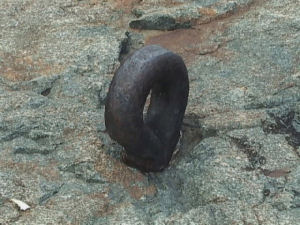
|
| Mooring ring attached |
Can these mooring stones be absolutely determined to be Norse? No. Can they be absolutely determined NOT to be Norse? No. The fact that there are similar items in known areas of the Old World inhabited by the Norse is certainly a factor that leans heavily towards the probability that at least some of these items are the real McCoy. Dating of these mooring stones is also of great subjectivity. When were they first used? When were they last used? One fact remains in place. For these items to have no medieval connotation would require every single one of them, on a case by case basis, to be disproven.
The discussion on mooring stones ranges on with many very intelligent pros and cons being brought to the table. As a matter of interest, many who are actually proponents of the mooring stone's Norse affiliations are playing the part of devil's advocate with the intent of presenting some solid scientific arguments against these same connotations. So far, for every argument 'against', an argument 'for' will counter.
Even experimental archaeology has played their part in this field. It has been determined that with a hand operated drill a person should be able to make one of these holes in an hour and a half. Hand chiseling however is considerably longer, taking seven to eight hours. There have been reports of much faster times by earlier settlers who chiseled some of these holes and I am sure experts in this field could cut out a hole in a record period of time. Even so, it would take at least a couple hours to accomplish. Enough of an effort that would mean making these holes was not a casual endeavor.
Have you ever considered how an iron ring can stay firmly anchored into a chiseled hole? Certainly not with crazy glue! Another scientific study of the mooring stones has determined that the iron spike placed in the hole was also constructed of a softened triangular shape. (Easily done by a blacksmith.) When twisted it would be wedged securely into place. Photographs quite obviously show their durability.
Some interesting reading material on this field is The Last Kings of Norse America by Robert Johnson and Janey Westin. These two researchers not only look at mooring stones but do their own examinations of the KRS and the Spirit Pond Runestone. Following the research of Hjalmar Holand they put forward the theory of a Norse colony called the Graeneveldi that inhabited the area we just looked at. We will refer to them further when doing our examination of the above mentioned runestones.
Here are some good web links regarding mooring stones:
http://mooring-stone-theory.blogspot.ca/
https://wynlandwest.blogspot.ca/2014/11/mooring-stone-and-harbor-2.html
https://www.norwegianamerican.com/featured/in-defense-of-the-kensington-runestone-stoneholes/
http://www.andywhiteanthropology.com/blog/category/stone-holes
Geographical location (estimated range): 45.303,-97.045 to -96.519
February 15, 2018
Hjalmar Holand
Before we continue further with our examination of artifacts I think this is a fitting time to look at a gentleman by the name of Hjalmar Holand. He plays a critical part in the unravelling of the Norse mystery of the Graeneveldi and he will be referred to a few more times in this dissertation.
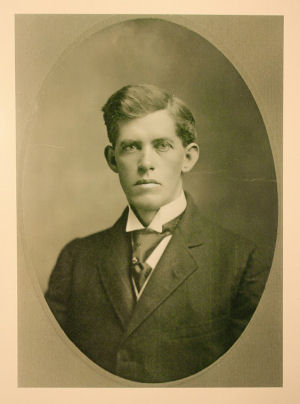
|
| Hjalmar Holand 1900 |
A firm advocate of the genuinity of the stone from the outset, it is very likely the KRS would have been lost forever if not for him. After having been declared a forgery the Ohmans took the runestone back home where it sat in a shed unnoticed for a number of years, relegated to being nothing more than a local curiosity. It is most likely that it would have eventually been forgotten. Holand however, immediately recognized the runic writing on the stone and ventured his own translation of what it said. His findings intrigued him so much he then made a detailed examination of the surrounding area, documenting and photographing many of the artifacts that have turned up. Many items were detailed with affidavits by the finders.
He also began researching the Mooring Stones of Minnesota, then recording their locations based on the premise that a Norse expedition came to the Minnesota area. Holand managed to trace a path of stones from the Red River to the KRS site. He also tracked a second grouping of these stones from Kensington. The fact that he successfully located these stones along his suggested route indicates that there must have been something correct in his theory. This brings up some interesting thoughts.
An expedition travelling in this country by waterway, or possibly by flooded plains (we used to raft around our back yard in the spring), would be using shallow draft boats. Large ships are hard to picture (unless they were built locally). So then, mooring rings are impractical, unless they were there for more than just the simple purpose of tying up boats. We already know they were multi-purpose. Perhaps these mooring stones were left as indicators for future visitors or colonists such as our road signs are for us today. They seemed to work for Holand.
This scholar did not limit his curiosity to only Minnesota but also looked into the New England area where he carefully researched the Newport Tower. It was his firm belief that this area was the Vinland of the sagas. His travels even took him to Europe where he was able to confirm many of his theories through detailed comparison, old documents and highly accredited experts. He was also one of the first to associate the Paul Knudsen Expedition to the KRS.
Holand wrote several books over the years that document his research and theories. Much of his information is very well backed up and what we know today can be based on his fundamental groundwork. A couple of his books that provide some interesting information:
Explorations In America Before Columbus
and
A Pre Columbian Crusade To America
Like many scholars, Holand did some excellent research. Most of his theories are quite viable. But also, as with every bit of research there are errors. Again, Holand was hampered by the times and did not have access to a lot of the facts we have today. LAM was unknown to him. So was the Spirit Pond Runestone and the Whetstone River mooring stones.
Thus with Holand's help, in our chronicle of possible artifacts and sites, we can specify Mooring stones in Minnesota. In Pope County alone, Leland Pederson has catalogued and mapped over 40 stones. It is generally believed that there are over 100 stones in the state of Minnesota alone.
March 15, 2018
Cultural Footprints
As I continue researching and cataloguing what is encountered (and try to make sense of it all) I find it neccesary to break up the results into specific geographic areas simply due to the volume of data that is being assembled. By doing this, our entire Norse presence becomes much more lucid as well. Within our examination we find that not only the Norse came here but numerous other cultures or groups. They have left their own identifiable footprints on this continent.
Ranging from ancient Sumerians, Phonecians, Minoans, Egyptians, Eutruscans, Romans, Celts, Africans, Hebrews, Chinese, Japanese, Southeast Asians, early Christians, Welsh, Irish and Knights Templar we find evidence that all were here to some extent. The melting pot of pre-Columbian America was just as well mixed as we are in our own society of today. Even though they are not Norse, it is important to be able to conceive just how extensive PCA (Pre-Columbian America) history really is and how completely different it is from what we were taught in school. Once we can gain this concept we can place our subjects, the Norse, more appropriately in our journey.
Later I am going to touch upon some of the artifacts and sites that have been found with an attempt to filter out some of the cultures that we encounter. Other items will be listed further in this blog where I consider them pertinent to our own examinations of the Norse.
The history of this world seems to revolve around wars and conflict. Ultimately, one society will conquer another and we thrive on the telling. However, there is also a vast history of non-turbulent contact between peoples and although usually not as dynamic, it is just as extensive and plays just as important a part in our history as does the warrior. When studying the peaceful contact between the old world and the new world cultures we find several factors that are fairly consistent as the groups meet, mingle and interrelate. Their offspring are mixed and subsequent modified societies emerge that are not one or the other but bits of both. Take the Metis for example.
Most predominant of these factors indicating blending is the use of 'loan' words where similar sounding words both have the same meaning. Our own language is loaded with these. Thursday = Thor's Dagr, brother = broder, saga = saga. My favorite is Norse to Iroquois: Loki.
Tied in with this is architectural similarities. We can compare building and construction styles, design, use of similar materials and matching date ranges. We have Sumerian Ziggurats in Inca country, Mandans building Viking style fortresses while Hopewellians build Celtic mounds and furnaces.
The cultures of the Old World have journals and histories while the New World people have their own histories, legends and myths. The Mandan claim they came from Europe, A chief by the name of 'Cornhair' terrorizes a neighboring tribe and many nations tell of a founding father coming from the sunrise in a large canoe.
The structure of various cultures can be compared from legal codes and practices to the similar status of women in a society. In the Norse example, we have outlawry and compensation for crime; divorce and landowning. Government infastructure can be compared. How many native cultures elect their chieftains?

|
| The Knox Halberd (photo:Holand) |
When all of these factors are blended together with the addition of physical evidence, we find that they will leave a legacy of their own. We arrive at a cultural footprint.
A good book that takes a serious look at the visitation or colonization of other civilizations is The Lost Colonies of Ancient America published in 2014 by Frank Joseph. He does a detailed breakdown of all the cultures we have mentioned above.
A website to have a look at is:
We can now begin our examination of the Norse presence in the west. We will separate this out to north midwest and south midwest. Since we started with Hjalmar in the north, let us continue that way.
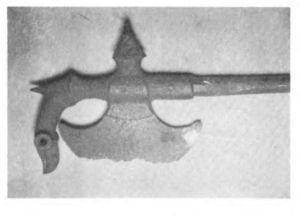
|
| A Contemporary Tobacco Cutter (photo:Holand) |
April 15, 2018
NORTH MIDWEST
Now we come to some iron artifacts.
Mount Vernon, South Dakota
The Knox Halberd 1946
Richard Knox found this medieval weapon near the edge of a slough. Holand undertook to have a full metalurgical analysis done to it and the halberd was determined to be of wrought iron with an absolute age of no less than 200 years.
There are more halberds coming up that were found in different locations and time frames. All are identical and have been identified as Norse by the University Museum of Oslo, Norway. There are also illustrations of them in Historia De Gentibis Septentrionalibus by Bishop Olaus Magnus 1555 where they are identified as ceremonial and carried by the king's bodyguard.
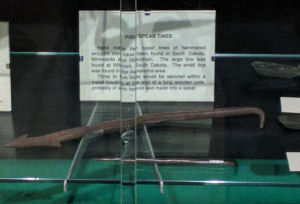
|
| Iron Fishing Tine at the Runestone Museum, Alexandria,MN |
Thus the importance of the metallurgical examination on this specific piece.
The Knox halberd was found in 1946. The other artifacts were found at pre 1930 dates. The halberd was cleaned by the finder after discovery.
An important point to keep in mind is the wear on the item. An original halberd would be in the shape of a crescent moon. The Knox halberd has an extensive amount of wear at the high point and appears to have been caused by a repeated slicing motion. One can see a slightly different pattern of wear on the tobacco cutter. It is synonymous with what one would expect when cutting stocks of long, leafy plants over a period of time, especially on an item of low grade metal.
Geographical location: 43.713,-98.269
**********
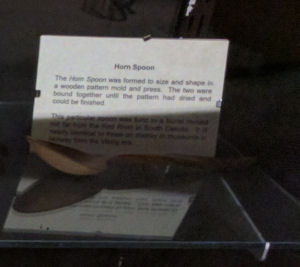
|
| Horn spoon at the Runestone Museum, Alexandria,MN |
May 15, 2018
LaBelle Creek, North Dakota
Firestriker 1870
North of the mooring stones at Whetstone River is LaBelle Creek, North Dakota. One of the metal pieces we encounter is a firestriker (or firesteel). This piece was found in 1870 by Ole Jevning. It is similar to others that we are about to examine and has been determined to be Norse.
Mooring stones have also been found here.
Geographical location: 45.942,-97.401
**********
At Red River, South Dakota a horn spoon was found in a burial mound. Although it could be Norse there is just as much of a possibility that it is Indigenous. Many of the native populations used spoons made of horn. Some of them are quite elaborate and the artwork is beautiful.
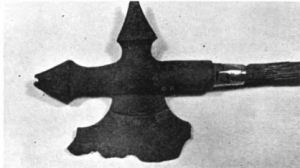
|
| Original photo of halberd showing the wooden handle by Holand |
June 15, 2018
Buxton, North Dakota, Frog Point
Halberd 1871
Here is our second halberd.
This was found by E. O. Estenson who was a boy at the time, coming west with his father to search for land to farm. Frog Point was a Hudson Bay Company trading post along the Red River and the sight of the first village in Traill County.
One day, while exploring the area, Estenson came across a handle sticking out of the eroded riverbank. It was 2 feet from the grassy surface top of the prairie. Buried at the other end of the handle was the iron halberd.
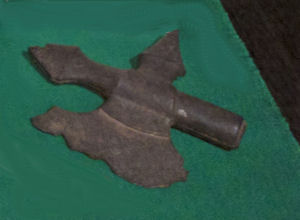
|
| Frog Point halberd at the Runestone Museum, Alexandria,MN |
The blade of this weapon shows extensive use and was most likely used for chopping or prying before being discarded.
One can clearly see that this halberd was made of very high grade iron due to the lack of deterioration. This indicates some very top quality workmanship as would befit an owner of high social status. At its time, this weapon would have been quite an expensive item.
Geographical location: 47.621,-96.884
July 15, 2018
ADDENDUM
Here are some recent corrections and addendums to the above posts. I recently took a trip to the Kensington Runestone and the surrounding area. I visited Frog Point, Hawley, Cormorant Lake, Sauk Center as well as the Museum in Alexandria. The KRS site was also looked at in great detail. I was fortunate to acquire more information and photos of many of the items we are looking at. This project is turning out to be substancial and I guarantee monthly blog entries
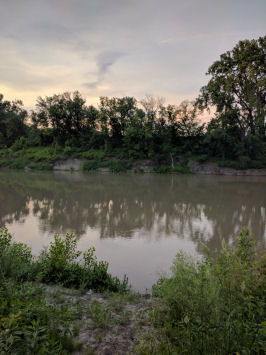
|
| Frog Point Riverbank. Note the erosion. (author) |
First, regarding Feb. 15 - Hjalmar Holand: Holand died in 1962, one year after LAM was found. At least he lived to know that many of his theories were sound. RIP Hjalmar.
******
The April 15 - Knox Halberd: The genuinity of the halberds has been questioned with the crux being a comparison with a contemporary plug tobacco cutter. Here are more details on the tobacco cutter and some corrections from our original blog:
The American Tobacco Company was formed in 1890. They produced a brand of plug chewing tobacco in 1896 named Battle Axe Plug Tobacco. As part of the promotion of this item they produced a tobacco cutter patterned after the Frog Point halberd. I believe they had two production runs of this item.
The earlier of these cutters was composed of two pieces. The main piece and the blade. This version can be identified by a heavy ring bottom at the base of the cutter where the wood attaches. It appears that most of these have screws to attach the blade where there were rivets on the original piece. The second batch (Hjalmar photo) appear to be of cast iron, single piece. The dating is in question but would be between 1900 and 1930.
******
The April 15 - Fishing Spear Tine came from Wilmot, South Dakota.
Geographical location: 45.409,-96.865
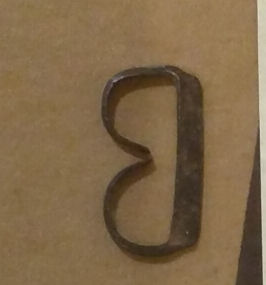
|
| The Labelle Firestriker. (Runestone Museum) |
Regarding the May 15 - Labelle Firestriker: A further examination of the firestriker (pictured at right) questions the Norse origin. The shape is not correct. Although there are many firestrikers of unusual patterns that originate from the Novgorod area, they are all two dimensional. The Labelle striker is three dimensional. It is possible it could be an eighteenth century trade item.
One point in its favor however is the age patina. It is similar to that of the halberd. This item needs more research and eventually testing.
******
More information on the June 15 - Frog Point Halberd. I was able to examine this piece more closely. It is indeed an item of high quality metal. The weapon was made in three pieces. Two decorative halves housed the blade. They were forged and riveted into place to secure it.
Since handle pieces and blade are of identical metal composition we are confident that the entire halberd was forged. I suspect the shape was originally taken from a mold and worked to perfection. Four rivets were put in place to hold the metal pieces together with another rivet to secure the wood handle. Somehow or other they would have been burnished to appear as a single piece.
One can imagine what this would have looked like when original. The metal would have been brilliant. I expect in a wilderness area it would have stood out quite
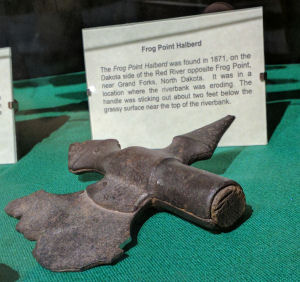
|
| Another view of the Frog Point halberd. (Runestone Museum) |
There is indeed still wood in the weapon. It appears to have been cut off flush with the metal. It is a prime candidate for carbon dating.
The methods used in the manufacture of this weapon are indicative of a master blacksmith as would befit a king's armorer.
August 15, 2018
Bottineau, North Dakota
Mooring Stones
I just recently read about this one so we have to jump back a wee bit. Bottineau is just south of the Canadian Border near the Turtle Hills of Saskatchewan. There has been reports of several in the area. Here is the link:
https://sites.google.com/site/stonebankorg/fabulous-nd/mooring-stone
Geographical location: 48.825,-100.461
******
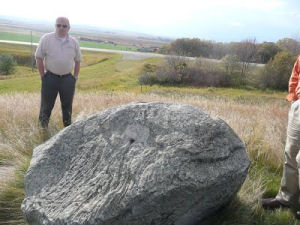
|
| Bottineau Mooring Stone |
Firestriker 1871
Another firestriker was dug up in 1871 along the banks of the Red River near Frog Point at Climax, Polk County, Minnesota. A farmer digging a post hole found this iron object two feet deep according to his report. It was discovered with the remains of an old campfire.
This firestriker (or firesteel as my southern counterparts like to call it) has been researched in great deal and as a matter of fact, spent some considerable time in Oslo, Norway at the University Museum where it rested with identical specimens. It is now in the Runestone Museum, Alexandria, Minnesota.
Argument that this firestriker was a seventeenth or eighteenth century native trade good was disproved by the University of Oslo based on size, style and identical match.
It is interesting to note the strata level is the same as the Frog Point halberd, two feet.
Geographical location: 47.608,-96.820
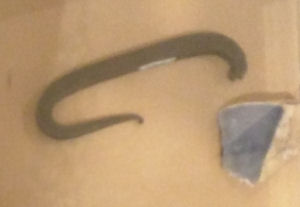
|
| The Climax Firestriker. (Runestone Museum) |
September 15, 2017
Buffalo River, MN
There have been reports of 14th century artifacts turning up in this area. There is no further information at this time.
Geographical location: 46.974, -96.782
******
Ulen Minnesota
Sword 1911
Just east of the red river a sword was plowed up in 1911. It was in a field, 7" deep when discovered.
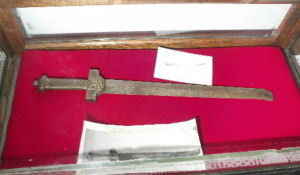 |
| The Ulen Sword |
At one glimpse it is easily determined that the style is not Viking or Norse. Therefore, what is this sword?
One of the closest comparison pieces is the French Glaive Ecole De Mars short sword. It features a square hilt and the same leaf pattern on the crossguard. The piled arms motif on the reverse is identical to one found on a scabbard tip of a revolutionary pattern sword. However, any known glaive swords have scale pattern grips while the Ulen sword has a diagonal pattern imitating wrapping.
This pattern is more concurrent with many early eighteenth century European swords.
Three comparision pieces are known. There is what appears to be a base metal theatrical sword with a Germany manufacture mark on it, however, the Ulen sword is steel with a brass hilt. Another piece, identical to the Ulen sword but completely intact was offered on e bay in 2012.
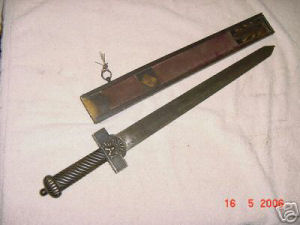
|
| Kirschbaum Copy |
Then, coming from a couple good websites, the solution. This sword (identical match) was listed by an edged weapon manufacturer out of Chicago by the name of Ames in their 1882 catalogue. It is identified as a theatrical sword. A German swordsmith called Kirschbaum also offered this item in their 1893 catalogue.
Here are the website links:
This documentation is pretty well self explanatory. Sadly, the Ulen sword is neither Norse nor French. This sword was a theatrical prop. Entertainment, at the time of the early settlers, was a premium art. A travelling troupe of actors would have carried something like this for the play Julius Caesar or the likes.The real mystery here however is: how did this theatrical sword with a broken tip come to be buried seven inches deep in the middle of a field in Minnesota?

|
| Mooring Stone at Hawley |
October 15, 2018
Skree Township, Hawley, Minnesota
Mooring Stone Holand #1
Hjalmar Holand began tracing the path of mooring stones from the Red River to Kensington. The first one he documented was found 7 miles south of Hawley. It was reported to be very old and there before any settlers came to the area.
Geographical location: 47.078,-96.267
******
Eglon Township, Hawley, Minnesota
Mooring stone Holand #2

Close up of the Hawley Mooring Stone hole
This stone was found 2 miles east of Hawley. It too was reported as being there before the early settlers arrived.
Geographical location: 47.078,-96.267
******
Thief River Falls, Minnesota
Brandvold Axe 1919
No further information at this time.
Geographical location: 47.078,-96.267
November 15, 2018
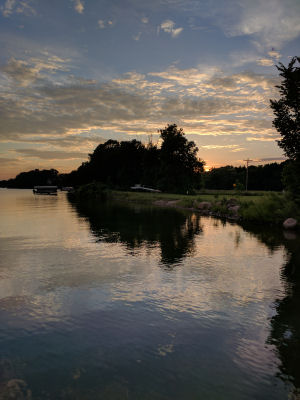
|
| North shore, Cormorant Lake |
Axe
Reported by Anderson 1994.
Geographical location: 45.573,-96.183
******
Stinking Lake, Minnesota
Mooring Stone Holand #3
In lake bottom now. Holand surmises it rolled off the hill and into the water.
Geographical location: 46.917,-96.162 Geographical location: 46.917,-96.162
******
Nelson Lake, Minnesota
Mooring Stone Holand #4
Geographical location: 46.800,-96.116 Geographical location: 46.800,-96.116
******
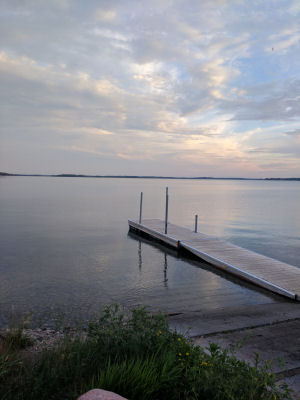
|
| Looking South, Cormorant Lake |
Mooring stone
Geographical location: 46.884,-96.097
December 15, 2018
Big Cormorant Lake MN
Mooring stone 1870
Firestriker 1870
Axe 1870
Big Cormorant Lake is about 75 miles north-northwest of Kensington. Holand claimed this is where the massacre described on the Kensington Runestone took place.
Mooring Stone
This stone was originally discovered by the party that Estenson belonged to. They were on their way west, looking at land. When the stone was found in 1870 it was stated to be weathered then. It was also reported by a different party in 1879.
Holand gave this stone the designation of #5.
Firestriker
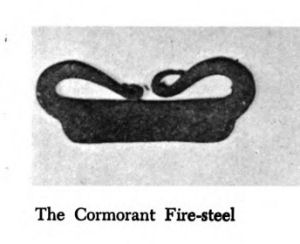
|
| The Cormorant Lake Firestriker (Photo- Holand) |
As a point of interest, this firestriker is of a different pattern than the others that have been discovered. This one has a thicker base to it and looks to be 10th-11th Century. It resides in the Runestone Museum, Alexandria.
Axe
This axe was originally placed in the Luther College Norwegian Museum. In 1964 the museum collection became separate from the college and was established as the Norwegian-American Museum. It is now known as Vesterheim Norwegian-American Museum.
This information is directly from the museum:
"It's artifact #LC0879. Description: 4 1/4" straight cutting edge. straight upper edge slanting up slightly diagonally from shaft. lower edge cuts up rapidly 2" from blade and meets shaft socket 2 3/8" from top. rectangular shaft socket tapering in from back. back of socket extends well below front. Overall dimensions 9 x 4 x 1.25"
The ax was found near Kensington, MN in May 1870 by a party of men who were looking for land. One was E.O. Estenson of Crookston, MN, who was the first homesteader of the
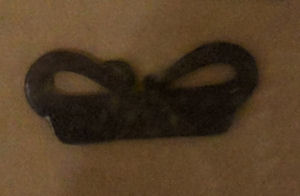
|
| Firestriker in the Runestone Museum |
In May 1870 there were no white settlers in Becker County, MN, where the ax was found--they began coming in June 1870 and there were no settlers around the lake until 1879 because the land was very hilly, swampy, and stony. Holand believed that "the axe is a memento of that catastrophe which took place there 600 years ago. The victorious Indians no doubt gathered up the white men's arms, but in a hurry this ax escaped their notice."
Next, R. W. Breckenridge from Iowa State University studied the ax in 1952. He identified it as a chopping ax. The style of ax was first developed in Ireland about 2000 years ago and used largely in Northern Europe and America until the late 1800s. He said that, in examining the steel under a microscope, it appeared that it had been produced in a stone furnace, which were in use in Europe during the late middle ages and until the late 1800s. There was a Des Moines Register article in 1952 about the ax. In it Breckenridge refers to another ax head in an Oslo, Norway, museum, that was similar and dated 1300. Otherwise, Breckenridge never really gives his opinion about the age of the ax (in the article or in our correspondence)."
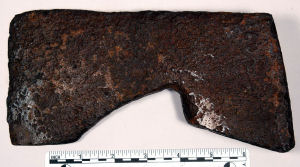
|
| Cormorant Lake Axe (Photo- Vesterheim Museum |